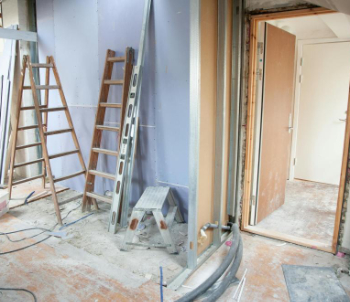Tilt up construction
Contents |
[edit] Introduction
This cost-effective building technique can produce a shorter completion time for construction projects. The main aspect of tilt-up construction that makes it unique is the way that the concrete structural supports, columns, and walls are created. These elements are all formed on the ground and then tilted into a vertical position with the assistance of a crane.
[edit] The tilt-up construction process
Due to its complexity, the process for this type of construction requires significant planning and organisation. Specific steps must be taken to ensure success:
- Evaluating the site.
- Engineering.
- Creating footings and floor slabs.
- Forming the tilt-up panels.
- Placing inserts, embeds and steel grids inside each form.
- Spraying forms with bond breaker chemicals.
- Concrete pouring and placement.
- Erection of panels and panel finishing.
Once the concrete floor slab has cured, the process of creating wall sections can begin. Typically, fiber boards or high-quality plywood are used to create forms for a project. However, steel or aluminum forms can also be used. Engineered blueprints help guide carpenters so that they know how to construct each element. Architectural features are incorporated into each element as well as the openings for windows and doors. Important construction items like studs, attachment plates and gussets are placed inside each form in preparation for pouring concrete.
The next step is crucial as it ensures the new concrete casts do not bond with the floor slab. A special chemical spray is used on the surface of the forms. Without this critical step, costly damage could occur. It's important to properly apply the correct chemical during this process.
After the bond breaker spray is used, steel rebar is constructed into a grid pattern inside of each form. Once finished, concrete is poured into each form to meet the specifications dictated by the blueprints for the building. When the curing process has completed, the forms are removed. The last step involves the attachment of rigging onto each section so that a crane can tilt or lift each panel into place.
These tilt-up structures can be extremely heavy, weighing more than 100,000 pounds. Headed studs and steel plates are used to connect the newly-formed concrete structures with the floor and roof. Some of these concrete structures may be used on the inside of the building structure as sheer walls. This helps provide extra reinforcement for any upper floors and the roof.
Insulation can also be used on these concrete panels. One method is to place it between two concrete layers during the casting process or to apply it either side of the concrete panels after they've been erected. One advantage of this type of construction is that it is fire resistant. Also, during the design process, plans can be designed so that the concrete slabs sag inward, which helps minimize the possibility of a complete collapse.
[edit] Typical uses
Tilt-up construction was first being used in America during the early 1900s. However, erection of the concrete slabs was completed with the assistance of tilt tables instead of cranes. During the construction boom after World War II, the popularity of tilt-up construction began to spread.
Warehouses were the most popular buildings being built after the tilt-up process was first introduced. Today, many types of buildings are created using this technique, including; hotels, industrial sheds, houses, offices and schools, and they can be single-story or multi-story structures.
[edit] Related articles on Designing Buildings Wiki
Featured articles and news
Considerate Constructors Scheme acquires Building A Safer Future
Acquisition defines a new era for safety in construction.
AT Awards evening 2024; the winners and finalists
Recognising professionals with outstanding achievements.
Reactions to the Autumn Budget announcement
And key elements of the quoted budget to rebuild Britain.
Chancellor of the Exchequer delivers Budget
Repairing, fixing, rebuilding, protecting and strengthening.
Expectation management in building design
Interest, management, occupant satisfaction and the performance gap.
Connecting conservation research and practice with IHBC
State of the art heritage research & practice and guidance.
Innovative Silica Safety Toolkit
Receives funding boost in memory of construction visionary.
Gentle density and the current context of planning changes
How should designers deliver it now as it appears in NPPF.
Sustainable Futures. Redefining Retrofit for Net Zero Living
More speakers confirmed for BSRIA Briefing 2024.
Making the most of urban land: Brownfield Passports
Policy paper in brief with industry responses welcomed.
The boundaries and networks of the Magonsæte.
London Build Fire and Security Expo
20-21 Nov and now with new Ambassador Programme..
The Scottish Building Safety Levy
Eight weeks of consultation closing on 18 November.
The grey, the brown and the golden rules of housing
shifting policies from the wild west of housing development.
Future proofing homes that are fit for purpose
Specification challenges and the role of plastic.
Thousands of new homes unlocked for brownfield sites
£68 million to 54 councils for neglected land into new homes.























